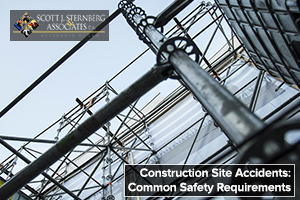June is celebrated for being National Safety Month, and we take the opportunity to provide a few construction safety tips and requirements that should be implemented in order to provide a safe working environment for employees and workers.
You may be surprised to know that the fatality rate in the construction industry stands at more than double when compared to all other industries’ average, with minor accidents on the rise. Construction sites are no less than a safety and health nightmare that is home to every conceivable hazard that you can imagine within a forever changing working environment.
Fall protection is pivotal
This is the most cited standard in the construction industry across the globe. This is one of the leading causes of worker death, and employers are required to assess job sites and implement proper fall protection systems to protect their employees. This includes providing workers with safety systems such as safety nets, personal fall arrest systems, and guard rails that prevent workers from falling off or walking off working surfaces that are six feet or more above the ground and have unprotected edges.
Guard rails are the best method to prevent someone from falling on the work site, while safety nets cushion a fall if someone does actually do just that. Fall protection also includes protecting workers from accidents, such as falling into elevator shafts, skylights, or into excavation sites. This may be done by insisting that workers wear hard hats and by installing toe boards and erecting canopies or barricading accident-prone areas to keep workers out.
Scaffolding
It is critical that all scaffolding is erected on solid ground, and is fully planked and erected at least ten feet (or more) away from power lines. Scaffolding should be erected with mid rails, guard rails, and toe boards to protect the workers working on, under, or around it. Scaffolds should be erected and disassembled by a professional and inspected by someone competent before it is used to ensure it is safe.
Stairways and ladders
A competent and reliable person must be assigned to check and inspect all ladders for snags before use each day. Defective ladders must be immediately marked and removed until they are properly repaired and fit for use.
All employees and workers must be trained on ladder safety rules and be coached on how to pick the right ladder for the job. All ladders on any construction site must conform to OSHA standards, whether they are job made ladders, portable ladders, fixed or self-supporting ladders. If workers on the site need to use energized electrical equipment, the ladders must have non-conductive side railings.
Aerial lifts
Employers are required to ensure that workers operating aerial lifts on a construction site are given proper training before they are authorized to use them. Retraining must be provided if the employee is caught operating the lift improperly, an employee is in an accident or sustains injuries while operating the lift, or if a new lift has been procured.
In addition to training employees on how to use an aerial lift, it is paramount that the equipment is in suitable operating condition. The working zones must be thoroughly inspected for hazards such as overhead obstructions, unstable surfaces, slopes, ditches, and low ceiling heights. Power lines must be de-energized when aerial lifts are in use.
Call us today!
If you or somebody you know has been involved in a construction site accident and has sustained grievous injuries, you may be able to file for workers’ compensation. Contact Sternberg | Forsythe, P.A. at (561) 687-5660, there is no reason to wait. Our attorneys will help you file a claim so you can receive rightful compensation for your losses.

